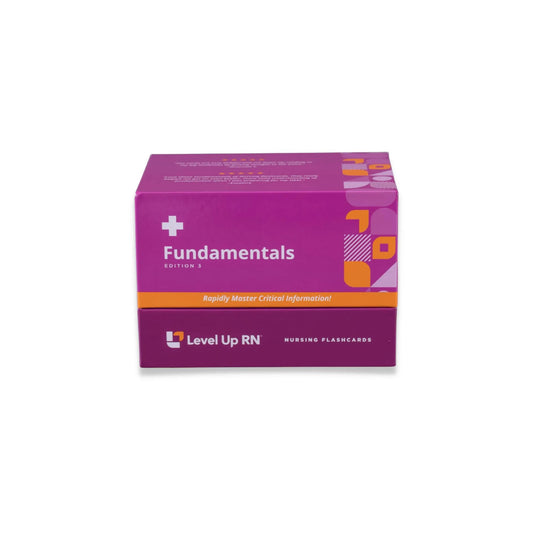When you see this Cool Chicken, that indicates one of Cathy's silly mnemonics to help you remember. The Cool Chicken hints in these articles are just a taste of what's available across our Level Up RN Flashcards for nursing students!
This article covers macronutrients, micronutrients, and body mass index. You can follow along with our Fundamentals of Nursing flashcards, which are intended to help RN and PN nursing students study for nursing school exams, including the ATI, HESI, and NCLEX.
Our Nutrition Essentials for Nursing flashcards are another great resource to help you learn and retain the most important nutrition concepts. Learn how nutrition plays a key role in patient wellness, and the essentials of patient teaching regarding nutrition that are part of every nurse’s job.
Fundamentals of Nursing - Flashcards
Macronutrients
Macronutrients provide the body with the energy it needs. They are important building blocks for metabolism and other metabolic functions.
The three most important macronutrients to know are carbohydrates, fats, and proteins.
Carbohydrates
Carbohydrates are the main source of energy for the body. Every gram of carbohydrate yields four kilocalories of energy, which means the body gets four calories for every gram of carbohydrate. For the physics-minded, a kilocalorie is the amount of heat required to raise the temperature of 1 kilogram of water one degree Celsius.
The recommended daily intake of carbohydrates is 45% – 65% of a body’s total caloric intake per day.
Fats
Fats, sometimes called lipids, are another good source of energy for the body. They’re also important for cell structure/function, temperature regulation (they keep our bodies insulated), protection of organs, and absorption of vitamins.
One gram of fat is nine calories; the recommended daily intake of fats is 20% – 35% of a body’s total caloric intake per day.
Proteins
Proteins are the body’s building blocks, helping to build and repair tissues, support the immune system, and provide energy.
We need to eat proteins because there are some proteins that our bodies cannot make by themselves. These are known as essential proteins. It’s important to replenish our protein stores so we can build new proteins to support all of our important metabolic functions.
Proteins, like carbs, offer an energy ratio of one gram to four calories.
The recommended daily intake of protein is 10% – 35% of a body’s total caloric intake per day.
Micronutrients
“Micro” means “small,” so micronutrients are things that the body needs to function properly, but that are only required in smaller amounts.
The body needs vitamins and minerals to carry out a range of normal functions. However, these micronutrients are not produced in our bodies and must be derived from the food we eat.
Vitamins
Vitamins are organic substances (molecules) that are generally classified as either fat soluble or water soluble.
Water-soluble vitamins
Water-soluble vitamins include B complex vitamins — thiamin (also known as vitamin B1), riboflavin (B2), niacin (B3), pyridoxine (B6), folate/folic acid (B9), cobalamin (B12) — and vitamin C.
Water-soluble vitamins require regular replacement because they are constantly flowing through the body and being eliminated in our urine.
Fat-soluble vitamins
Fat-soluble vitamins include vitamins A, D, E, and K.
Because these vitamins are fat soluble, they are stored in the body for longer, which means there is an increased risk for toxicity with excess consumption. In large amounts, these could become lethal.
Minerals
Minerals are inorganic elements present in soil and water, which are absorbed by plants or consumed by animals.
Major minerals (electrolytes)
Major minerals include our electrolytes (calcium, magnesium, sodium, and potassium), which we’ve talked about previously.
Our Med-Surg Nursing video series, which follows our Medical-Surgical Nursing Flashcards, offers an in-depth look at electrolytes and acid-base balance.
Trace minerals
Trace minerals are things like copper, fluoride, iodine, selenium, zinc, and iron, which is one of the important trace minerals.
Body mass index (BMI)
Body mass index (BMI) is a measure of body fat based on a person's height and weight (note that it is a measurement that applies to adult men and women).
BMI is calculated by dividing a patient's weight (in kilograms) by their height (in meters squared).
- A BMI less than 18.5 is an underweight BMI
- 18.5 to 24.9 is denoted as healthy (or average or ideal)
- 25 to 29.9 is overweight
- Any number over 30 is considered obese



1 comment
You can remember water soluble by the saying “Drinking enough water can B complex”!!! :)